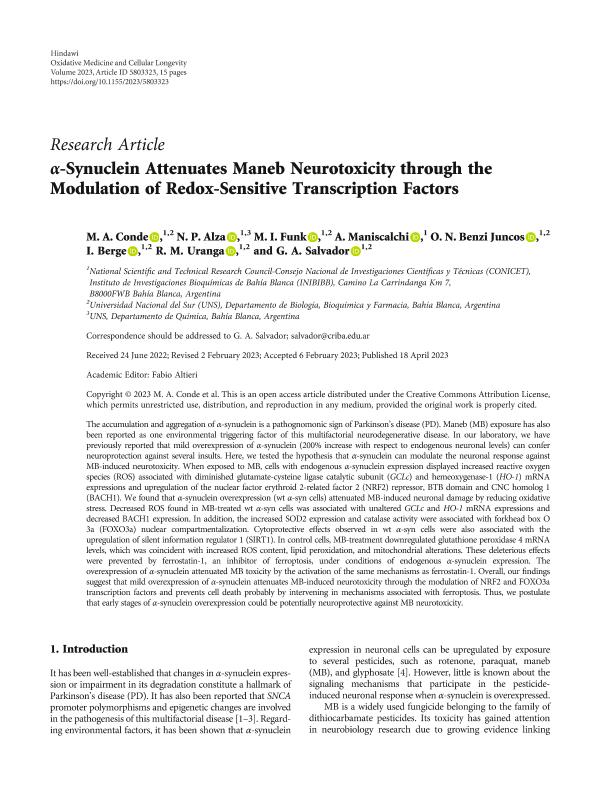Artículo
α-Synuclein attenuates maneb neurotoxicity through the modulation of redox-sensitive transcription factors
Conde, Melisa Ailén ; Alza, Natalia Paola
; Alza, Natalia Paola ; Funk, Melania Iara
; Funk, Melania Iara ; Maniscalchi Velásquez, Athina del Valle; Benzi Juncos, Oriana Nicole
; Maniscalchi Velásquez, Athina del Valle; Benzi Juncos, Oriana Nicole ; Bergé, Ignacio
; Bergé, Ignacio ; Uranga, Romina Maria
; Uranga, Romina Maria ; Salvador, Gabriela Alejandra
; Salvador, Gabriela Alejandra
 ; Alza, Natalia Paola
; Alza, Natalia Paola ; Funk, Melania Iara
; Funk, Melania Iara ; Maniscalchi Velásquez, Athina del Valle; Benzi Juncos, Oriana Nicole
; Maniscalchi Velásquez, Athina del Valle; Benzi Juncos, Oriana Nicole ; Bergé, Ignacio
; Bergé, Ignacio ; Uranga, Romina Maria
; Uranga, Romina Maria ; Salvador, Gabriela Alejandra
; Salvador, Gabriela Alejandra
Fecha de publicación:
04/2023
Editorial:
Landes Bioscience
Revista:
Oxidative Medicine and Cellular Longevity
ISSN:
1942-0900
e-ISSN:
1942-0994
Idioma:
Inglés
Tipo de recurso:
Artículo publicado
Clasificación temática:
Resumen
The accumulation and aggregation of α-synuclein is a pathognomonic sign of Parkinson's disease (PD). Maneb (MB) exposure has also been reported as one environmental triggering factor of this multifactorial neurodegenerative disease. In our laboratory, we have previously reported that mild overexpression of α-synuclein (200% increase with respect to endogenous neuronal levels) can confer neuroprotection against several insults. Here, we tested the hypothesis that α-synuclein can modulate the neuronal response against MB-induced neurotoxicity. When exposed to MB, cells with endogenous α-synuclein expression displayed increased reactive oxygen species (ROS) associated with diminished glutamate-cysteine ligase catalytic subunit (GCLc) and hemeoxygenase-1 (HO-1) mRNA expressions and upregulation of the nuclear factor erythroid 2-related factor 2 (NRF2) repressor, BTB domain and CNC homolog 1 (BACH1). We found that α-synuclein overexpression (wt α-syn cells) attenuated MB-induced neuronal damage by reducing oxidative stress. Decreased ROS found in MB-treated wt α-syn cells was associated with unaltered GCLc and HO-1 mRNA expressions and decreased BACH1 expression. In addition, the increased SOD2 expression and catalase activity were associated with forkhead box O 3a (FOXO3a) nuclear compartmentalization. Cytoprotective effects observed in wt α-syn cells were also associated with the upregulation of silent information regulator 1 (SIRT1). In control cells, MB-treatment downregulated glutathione peroxidase 4 mRNA levels, which was coincident with increased ROS content, lipid peroxidation, and mitochondrial alterations. These deleterious effects were prevented by ferrostatin-1, an inhibitor of ferroptosis, under conditions of endogenous α-synuclein expression. The overexpression of α-synuclein attenuated MB toxicity by the activation of the same mechanisms as ferrostatin-1. Overall, our findings suggest that mild overexpression of α-synuclein attenuates MB-induced neurotoxicity through the modulation of NRF2 and FOXO3a transcription factors and prevents cell death probably by intervening in mechanisms associated with ferroptosis. Thus, we postulate that early stages of α-synuclein overexpression could be potentially neuroprotective against MB neurotoxicity.
Palabras clave:
MANEB
,
NEUROTOXICITY
,
NRF2
Archivos asociados
Licencia
Identificadores
Colecciones
Articulos(INIBIBB)
Articulos de INST.DE INVEST.BIOQUIMICAS BAHIA BLANCA (I)
Articulos de INST.DE INVEST.BIOQUIMICAS BAHIA BLANCA (I)
Citación
Conde, Melisa Ailén; Alza, Natalia Paola; Funk, Melania Iara; Maniscalchi Velásquez, Athina del Valle; Benzi Juncos, Oriana Nicole; et al.; α-Synuclein attenuates maneb neurotoxicity through the modulation of redox-sensitive transcription factors; Landes Bioscience; Oxidative Medicine and Cellular Longevity; 2023; 5803323; 4-2023; 1-15
Compartir
Altmétricas



